#just in general when dealing with exploitation ot oppression-
Explore tagged Tumblr posts
Text
Rallying around a few key figures to take down is good for essay narrative and to spread word about shitty people, but the thesis of the essay surrounding the ethics of plagiarism and "content" are so important and effective. Like, sure I hate Somerton and Internet Historian or whoever now, but the video also left me with a deeper appreciation of my voice as a writer because unlike those idiots, it's honest and my own. You should come out of that video with an appreciation for original artistic expression more than a hate boner for some guys.
I feel like those of us who are longtime Video Essay Enjoyers™ have been aware something was suss about James Summerton (I remember when Lawrence called out Summerton for stealing their Hannibal essay years ago) for a while. But I think it's cynical to reduce Hbomberguy's vid to just a "dunk" when it's more of an odyssey railing against how influencer and content culture devalues the work of culture critics, academics, and activists. As Harris said, it's not a problem exclusive to Summerton, but a corrosive attitude baked into late capitalist "content" culture. The video is a clear exploration of the consequences of all media and art being flattened into "content" creates a system where the labor of marginalised creatives and storytellers are exploited and stolen by people with more privileges and resources. As someone who has witnessed rich tiktokers quote articles and posts I've written verbatim without credit to make money from their 1000s of followers, this video hit super hard for me. From James Summerton claiming the works of dead gay activists, to Charli D'Amelio building a career from stealing dances created by Black tiktokers - plagiarism is often inseparable from discrimination and exploitation of labor rights. Harris' video is about how the nature of influencer content culture has further exacerbated the exploitative systems that already existed, wrapped up as YouTuber drama analysis. But I hope people don't miss the forest for the trees and remember you should always be citing your sources, fact checking, and be very wary of people who don't. And for the love of God, please stop getting your information exclusively from video essays, tiktoks and podcasts.
#video essay#hbomb#rb chain#well said op i just wanted to add my feelings to#just in general when dealing with exploitation ot oppression-#-supporting the harmed is more important than attacking the aggressors yknow#shut the heck up#(<- my talking tag)
22K notes
·
View notes
Text
Winterfell’s Daughter. On Sansa Stark (part 15)
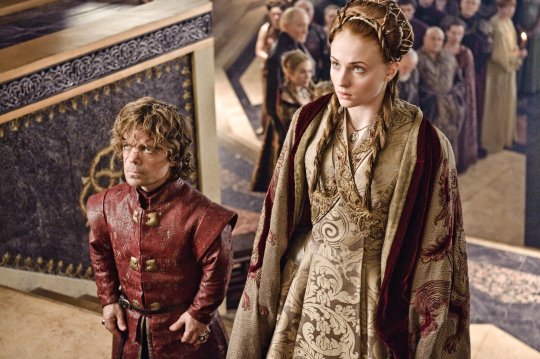
I’ve previously written a series of essays that analyse Sansa Stark’s narrative arc in Game of Thrones - during season 1 (Part 1, Part 2, Part 3, Part 4, Part 5, Part 6) and during season 2 (Part 7, Part 8, Part 9, Part 10) and now during season 3 (Part 11, Part 12, Part 13, Part 14).
As I’ve repeatedly stated, Sansa’s season 3 arc revolves around her political importance as Robb Stark’s heir apparent since her younger brothers Bran and Rickon are dead in the eyes of Westeros. Several major power players attempt to secure Sansa in order to control her claim to the North but it is the Lannisters who win that political game by wedding her to Tyrion after Petyr Baelish revealed the secret plan of the Tyrells to marry Sansa to Ser Loras. In this post, I’m going to take a closer look at how the wedding between Sansa and Tyrion plays out in episode 8.
BEFORE THE WEDDING
In my previous post, I criticized the manner in which the show frames Sansa’s reaction to the fact that she is forced to marry Tyrion Lannister - a marriage designed to exploit her status as Robb’s heir, a marriage predicated upon a plot to murder her brother and his pregnant wife so that Sansa will become the Key to the North in truth. It is a diabolical plan when you really think about it but the show mainly presents this whole thing from Tyrion’s perspective and when we are shown Sansa’s reactions, they are framed as shallow and intolerant (i.e. she’s not attracted to Tyrion because he’s a dwarf). The fact that she’s the victim in this scheme is effectively glossed over in episode 7 when Margaery attempts to console her.
Fortunately, the show turns out to be rather inconsistent in terms of how it frames Sansa’s reaction to this marriage in episode 8 where Tyrion comes to see her before the ceremony. The scene starts with a close-up of Sansa’s doll, the one that Ned gave her after he killed Lady. This doll may have functioned as a symbol of Ned’s guilt (x) and a reminder of Lady’s death in the beginning but after his death, it has come to mean something else for Sansa. Now it is the last tangible link to her father as well as a source of comfort to her (x). It is also a visual reminder to the audience that Sansa is still a child – and too young to get married! This is something that the show also explicitly states – both Shae and Tyrion call her a child within the context of marriage and sex, which really drives home how callous Tywin Lannister is in his exploitation of her claim to the North.
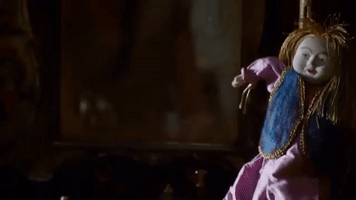
After the close-up of the doll, the camera pans up and we see that the doll is placed on Sansa’s dressing table, next to the mirror wherein we see her reflection as her maids prepare her for her wedding. There’s a knock on the door and Tyrion enters the room, his reflection joining Sansa’s in the mirror. Sansa stands up to greet her intended while Shae remains at her side.
Sansa: You look very handsome, my lord.
Tyrion (sarcastically): Oh, yes. The husband of your dreams. But you do look glorious.
Sansa fidgets, wringing her hands nervously as Tyrion asks for a moment alone with her. The conversation that follows is very awkward, mostly because Tyrion repeatedly says the wrong things, then realizing his blunders and trying to backtrack.
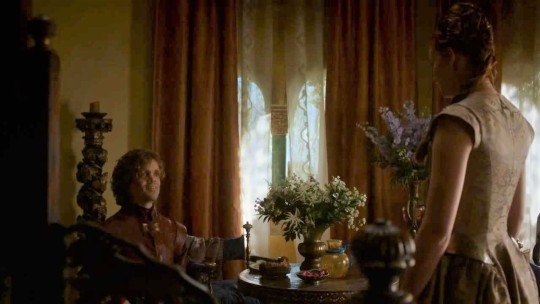
Tyrion: My lady, I want you to know. I didn’t ask for this.
Sansa (tonelessly): I hope I will not disappoint you, my lord.
Tyrion: No, don’t. You don’t have to speak to me as a prisoner. You won’t be a prisoner after today. You’ll be my wife.
This is a rather tactless utterance on Tyrion’s part. The fact remains that Sansa IS a prisoner – and the marriage is designed to keep her a permanent one. Tyrion may not have asked for this marriage but Sansa never gave her consent and she isn’t in a position to refuse. This is a FORCED marriage and she is not obligated to try to make the best of it or relieve Tyrion of his unease. However, she doesn’t dare to express her displeasure. Instead we see Sansa utilizing her trademark courtesy as a piece of emotional armour, keeping up a wall of icy politeness to keep Tyrion at arm’s length.
Tyrion: I suppose that is a different kind of prison.
So he does understand but then he immediately tries to forge a connection in another way, only to fail again.
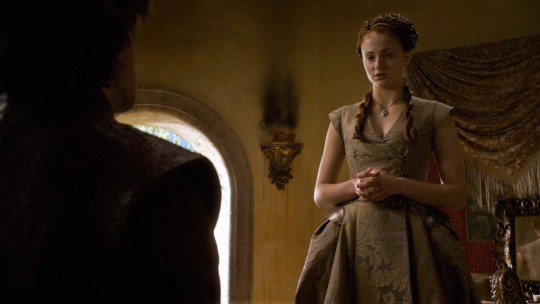
Tyrion: I just wanted to say… I’m just trying to say, very badly… I just… Just want to say I know how you feel.
This is just incredibly presumptuous of him. While he didn’t ask for the marriage, his feelings cannot be compared to Sansa’s. Her hopes for freedom have been crushed and she can only look forward to a lifelong imprisonment as the Lannisters attempt to steal her home. Tyrion is trying to make himself feel better because he knows that this marriage is designed to disenfranchise her while it is set up to benefit him. Thankfully, Sansa refuses to play along here.
Sansa: I doubt that very much my lord.
Tyrion: You’re right. I have no idea how you feel. And you have no idea how I feel.
It is clear that Sansa’s impassive demeanour makes Tyrion very uncomfortable, which makes him defensive. However, he is also very much aware of how wrong it is of Tywin to force Sansa into this marriage and he’s trying to make himself feel a bit better about the role he is to play in this farce.
The camera cuts to a close-up of Tyrion taking Sansa’s hand.

Tyrion: But I promise you one thing, my lady. I won’t ever hurt you.
Finally, Tyrion strikes the right chord. He ought simply to have lead with an acknowledgement that she doesn’t want this marriage but that he’ll never hurt her. He takes her arm and they leave her chambers. Then the camera cuts to an exterior view of the Sept of Baelor where the wedding ceremony is to take place.
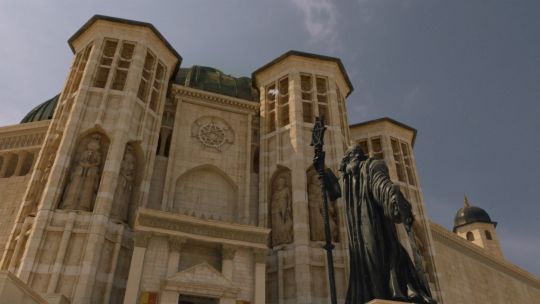
What is notable about this shot is the fact that the cinematographer uses a frog’s eye perspective (from below), which makes the building loom threateningly over the spectator. This is a good example of how the camera work can be invested with emotion. The prospect of the wedding and the marriage is an oppressive threat for Sansa – so one can argue that the first view of the Sept of Baelor is set within her POV and the audience is invited to share it through the visual language.
THE CEREMONY
After a barbed conversation between Margaery and Cersei, the camera cuts to an exterior view of the doors to sept, shot from the frog’s eye perspective that lends the visuals an oppressive, even threatening quality. As the doors are slowly opening, Sansa walks into frame until she is framed by the door way.
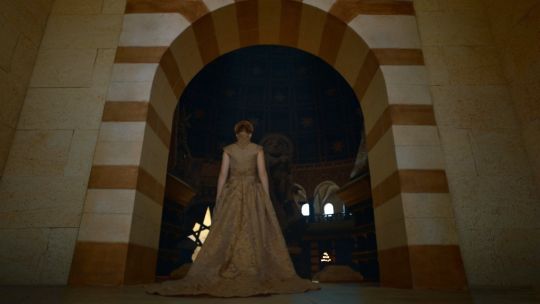
Then the camera cuts to an OTS (over the shoulder) shot with Sansa framed by the light from the open doorway and a pair of septas.

She’s the visual focal point of this scene though the OTS shot locates the camera (and thus the eye of the audience) within Tyrion’s POV - since the OTS shot is a device often used to anchor a shot within the POV of a given character.
The camera gets to peek over the shoulder of our main talent and assumes a point of view like that of our talent. The camera (and therefore the viewing audience) sees directly what the main talent sees. Granted, the face of the actor is hidden from view, so we do not know what he or she may be thinking or feeling from this angle, but since the audience is placed into the shot from the character’s point-of-view (POV), the audience is encouraged to do the thinking and feeling for the character or as the character more directly. This is sort of an objective – subjective shot type where you get a privileged point of view from what is usually a more neutral camera angle. (x)
The OTS shot is followed by a close-up of Tyrion - this reaction shot also functions to make clear that we are dealing with Tyrion’s experience as Sansa enters the sept. We are still within his POV.
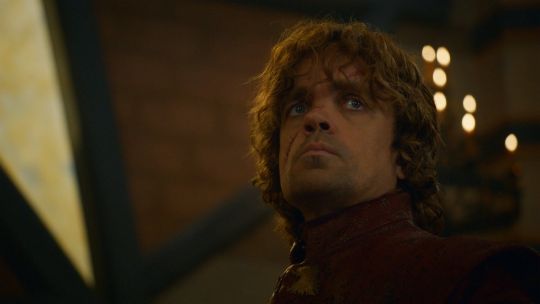
A reaction shot is one of the basic units of film grammar and it is used as part of the non-verbal story-telling in order to express the inner life of the characters:
A reaction shot usually implies the display of some sort of emotion on the face of the actor being shown, and is thus most commonly a close-up shot (although a group of actors may be shown reacting together). A reaction shot is also generally bereft of dialogue, though this is not an absolute rule. Its main purpose is to show an emotional response to the immediately preceding action or words of another character in the scene, or to an event in the immediately preceding scene which may or may not involve another actor (e.g., an explosion, monster, empty room, etc.) (x)
There are a lot of reaction shots in this scene as we see the various characters respond to what is happening - and since this is a fairly long scene with very little dialogue, these shots are quite important in order to lend the proceedings emotional intensity.
After Sansa has moved into the sept, Joffrey approaches her with a swagger and a smirk. He can hardly contain his glee because he’s using this event to torture her emotionally. He reminds her that her father is gone and since the King is the Father of the Realm, he’ll give her away to her husband-to-be. The fact that Joffrey, who is responsible for Ned Stark’s death, is going to act as proxy for Sansa’s father during the ceremony just underscores how much of a farce this wedding is.
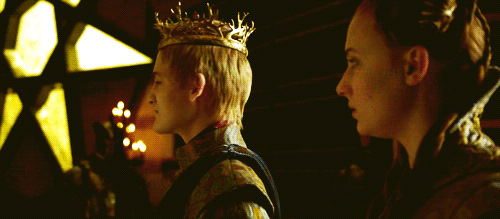
Sansa reluctantly takes his arm and they begin to walk forward as the doors close behind them.
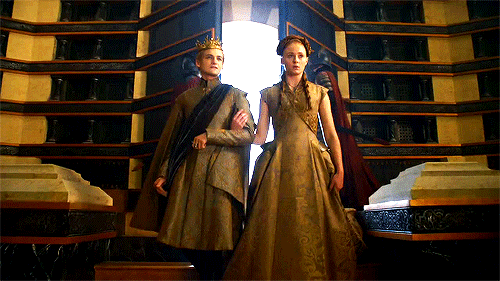
The walk up to the altar takes a fair bit of time - from the moment that Sansa enters the sept and until she stands at the altar - is about 1:30 min long. That is, in fact, a very very long in terms of cinema and television. The moment of her approach to the altar is dragged out to an almost uncomfortable degree - and this underscores the awkward and uncomfortable nature of the event.
Joffrey and Sansa ascend the stairs to the altar and as they come abreast with Tyrion, Joffrey takes away the little stool that Tyrion was to use for the cloaking of the bride. Because Joffrey is a little shit who likes to humiliate people, especially the two he seems to hate the most: Tyrion and Sansa.
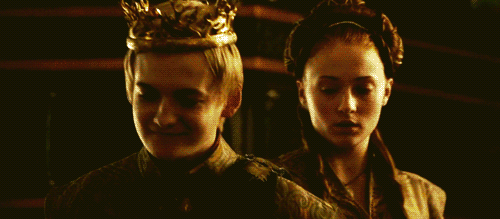
After this little piece of assholery from Joffrey, Sansa and Tyrion face the alter and the septon. Once again we get an OTS shot, this time from the septon’s POV. This shot is angled from a bird’s eye perspective (from above), which is the opposite of the frog’s eye perspective - but the effect is the same. This angle lends the scene an oppressive quality, which helps to convey how unhappy event this wedding is for both Sansa and Tyrion.

Septon: You may now cloak the bride and bring her under your protection.
Sansa turns her back on Tyrion so that he can put the Lannister cloak on her shoulders. However, Joffrey has removed the stool that was provided for this purpose. Tyrion shakes out the cloak and approaches Sansa. A wide-shot makes it clear that it is impossible for him to cloak her when she remains standing.
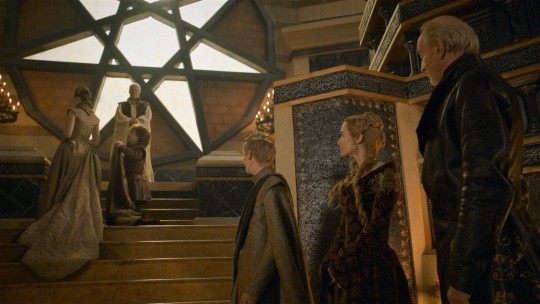
Sansa remains standing for quite a bit of time while Tyrion struggles with the cloak. In fact, she remains standing for 10 whole seconds, which is a LONG time in terms of television. Long enough for the crowd to begin laughing – in fact, the scene includes a number of reaction shot of various people laughing.
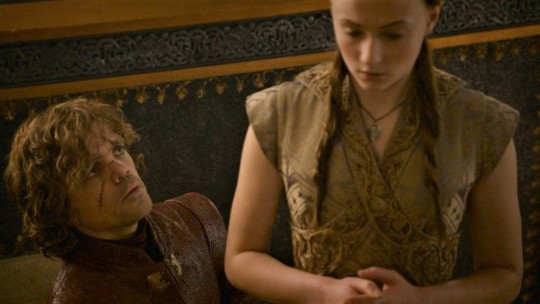
In the end, Tyrion has to ask Sansa to kneel, which she eventually does.

This scene is somewhat different than the way it is portrayed in the books where Sansa refuses to kneel for the cloaking ceremony and Tyrion eventually has to resort to use Ser Dontos as a stool.
The bride's cloak he held was huge and heavy, crimson velvet richly worked with lions and bordered with gold satin and rubies. No one had thought to bring a stool, however, and Tyrion stood a foot and a half shorter than his bride. As he moved behind her, Sansa felt a sharp tug on her skirt. He wants me to kneel, she realized, blushing. She was mortified. It was not supposed to be this way. She had dreamed of her wedding a thousand times, and always she had pictured how her betrothed would stand behind her tall and strong, sweep the cloak of his protection over her shoulders, and tenderly kiss her cheek as he leaned forward to fasten the clasp. She felt another tug at her skirt, more insistent. I won't. Why should I spare his feelings, when no one cares about mine? (ASoS, Sansa III)
The question is: Why did the show make this change? I suspect that this change was made for practical reasons. Having Peter Dinklage balance on the back of another actor while putting an unwieldy piece of fabric on Sophie Turner seems a bit unsafe for him. He could easily fall and hurt himself in such a scenario. So the way the scene played out may just have been a pragmatic solution to a practical problem in order to prevent a situation where an actor could possibly be injured.
Many fans were very upset with this change and so was I at first because it seemed as if the writes removed what little agency Sansa had left in this situation. However, upon a re-watch I have changed my stance on this issue. Once again, I want to point out that Sansa remaining standing for the duration of 10 seconds is almost an eternity in terms of cinema! The fact that Tyrion literally has to beg her to kneel does highlight that she is quietly refusing to make things easy for him because she is being forced into this marriage.
Her action is a piece of quiet resistance on her part but it is very subtle – so subtle that it is very easy to overlook unless you pay attention and think critically about the way that this scene plays out.
youtube
(The cloaking scene begins at timestamp 6:20)
After the cloaking, Tyrion and Sansa face the High Septon who proceeds with the ceremony. We get a close-up of Sansa with a downcast gaze as sighs audibly.

High Septon: We stand here in the sight of the Gods and to witness the union of man and wife. One flesh, one heart, one soul. Now and forever.
The scene ends here - and we don’t get to see the rest of the ceremony.
A CURIOUS OMISSION
Re-watching this scene, I noticed something odd. What is interesting here is the fact that the wedding ceremony doesn’t include the most important parts of the way that a wedding is conducted in the Light of the Seven:
The hand fasting.
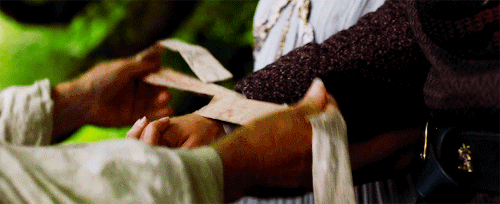
The recitation of the wedding vows. (Father, Smith, Warrior, Mother, Maiden, Crone, Stranger. I am hers/his and she/he is mine, from this day, until the end of my days)

This omission becomes even more glaring in comparison with Edmure Tully’s wedding that takes place in the very next episode because this wedding scene includes ALL the ceremonial elements of a wedding performed in accordance with the religion of the Seven:
The cloaking of the bride.
The hand fasting where the hands of the couple is bound together.
The recitation of the traditional wedding vows.
It begs the question why the show omits these elements during the wedding of Sansa and Tyrion. One possibility is that the show didn’t want to depict two full wedding ceremonies back to back - but if that is the case, then why not show the full ceremony with Tyrion and Sansa since their wedding takes place in episode 8 and Edmure’s wedding takes place in episode 9. Yet it is Edmure’s wedding that shows all the elements of a Westerosi wedding in the Light of the Seven.
Furthermore, after investigating the issue further, it is worth noting that EVERY OTHER WEDDING performed in the Light of the Seven are all shown to include either the hand fasting and/or the reciting of the vows! Even in scenes where the wedding ceremony is truncated - like in the weddings of Margaery to first Joffrey and then to Tommen. Whether it is Robb/Talisa, Edmure/Roslin, Margaery/Joffrey, Margaery/Tommen or Rhaegar/Lyanna - the weddings always feature the hand fasting and/or the recitation of the wedding vows.
So I cannot help but conclude that the rather conspicuous omission of the two most binding elements of the wedding ceremony in Sansa and Tyrion’s wedding is not only by design but that it is also meaningful. Since their marriage is never consummated, its validity remains open to doubt and I wonder whether the omission of the crucial elements of a Westerosi wedding ceremony is a subtle hint that the marriage is a sham.
To be continued...
(GIFs not mine)
#game of thrones#sansa stark#winterfell's daughter#character analysis#tyrion lannister#joffrey baratheon
149 notes
·
View notes
Text
Look Forward in Anger
Jerry Rubin, Berkley Barb, 17 November 1967
What did the Pentagon demonstration mean? Conbined with Oakland, Madison and other local actions through the week, it marked the beginning of disruption as a leading strategy for the white peace movement.
Johnson had to send his busy 82nd Airborne Division, veterans of the Dominican Republic and Detroit, to protect the Pentagon because he knew damn well that there were thousands of angry young people there who had come to tear that place up.
And that’s where it's at. We’re angry. We’re angry like Che. There are thousands of young people in this country who want to get the ‘‘white man” out of us, who choose the lot of the oppressed in the world. This system lives by murdering in Vietnam, exploiting the world, and killing black people at home; and we say to hell with the middle class "security” and phony status games, we are going to screw up this society.
And we can do it too. We can force Johnson to bring the 82nd Airborne Division and 100,000 more troops to Chicago next August to protect the Democratic National Convention. With luck, Johnson will get himself nominated under military guard. We can disrupt the traffic of America’s major cities. Who knows—some night, a draft board may just disappear.
The campus movement is going so fast that one can imagine the date a few years hence when a nationally coordinated strike will paralyze the major knowledge factories of the nation—shut them down for good with one national demand: America, dismantle your massive murder machine.
The white rebellion is on. An alive section of the peace movement—mostly its under-35 group—is realizing that what we need is not a peace movement, but a movement for liberation. Fighting American involvement in Vietnam is the same as liberating ourselves from privileged positions in a sick society based on a racist and selfish morality. Our task is to create dramatic and creative confron(tatio; which put people through tremendous, radicalizing changes, releasing energy and exciting the imagination.
The goal? A massive white revolutionary youth movement which, working in parallel cooperation with the rebellions in the black communities, could seriously disrupt this country, and thus be an internal catalyst for a breakdown of the American ability and will to fight guerillas overseas.
Thus defeated abroad by peasant revolutionaries, and disrupted from within by blacks and whites, the empire of the United States will find itself faced with rebellions from 15 different directions.
The job will be long and hard, and we must have a life-time perspective, a 30-year timetable. Our organizing emphasis should be on the young—on those masses of middle class dropouts who are bored by the bullshit they hear at home and in school.
It's paradoxical. This country whose main value is money has produced a generation of young [indecipherable]—people who believe in the possibility of a society where people live and share without domination by race, money or military force. Out of the ugliness of a society of slums and napalm come people with a truly beautiful vision.
The base of a liberation movement lies in the actions of the single individual. The revolution begins with oneself. We must break personally with the American system. This means countless acts, from draft resistance and tax refusal to organizing disruption; it means using our position in the university or the society to subvert the system, or dropping out and forming our own communities. It means giving up 2S deferments if we’re students; it means encouraging kids to run away from their middle class homes.
It is a series of individual, liberating acts which will add up to a mass, collective movement; and the collective strength lies in the strength of the one individual to say "no,” to mean it, and to carry it out in the only way possible—through action.
Words don’t make it. Words can be co-opted too easily. Words can fool. The revolutionary movement in America can not grow from speeches or pamphlets or messages of support. Or ads in the New York Times (better publish them in the New York Daily News). The movement needs individuals who will change their own lives.
We’re never going to be able to have the free advertising that belongs to Huntley-Brinkley or Bobby Kennedy. Our weapon lies in our ability to take actions which are forceful examples to others. Our weapon lies in our ability to create crises in the society which embarrass the military industrial complex internationally, force the government to continue to lose authority, and win more people to our side through action.
Symbolic actions are important. The dramatic burning of an American flag communicates our feeling that American nationalism is evil to the world. The beautiful, continual burning of draft cards—hundreds of them one after another—in front of the Pentagon symbolized the liberation of people from the murderous, coercive conscription system. The burning of money by the Diggers at the Stock Exchange said: Money is just paper; stop all those money games, you money freaks; let’s use money to solve human needs.
One way to look at our movement is as live theater. If it moves people, people will join us. Music is a major force for social change. Also film. A demonstration is theater.
The worst thing you can say about a demonstration is that it is boring, and one of the reasons that the peace movement has not grown into a mass movement is that the peace movement—its literature and events—is a bore. Good theater is needed to communicate radical content.
The main goal of the peace movement should be to liberate energy, to free the passions of man. One action planned by the Diggers soon in New York is for a massive celebration of the end of the war in Vietnam—possibly 10,000 people in Times Square, dancing and kissing, with noise-makers, flying confetti and free beer. It really ended. Feels good. Here’s how it’s like. Wow.
It’s no longer true that the more moderate the movement, the greater the possibility for a mass base. The best possibility for a mass revolutionary youth movement today is a movement based on directness and honesty, on a total alienation from the system, on a lack of defensiveness, and on an identification and support for those revolutionaries in Vietnam, Bolivia and Detroit who are giving their lives in struggle against American power.
And the distinction between "politico” and "hippy”? Bullshit. The media helped create those false distinctions. The Pentagon demonstration wiped them away. We were all politicos and we were all hippies.
At the Pentagon we all smoked pot, we all realized the nature of imperialism, we all related to one another as living, human beings, sharing food and living in collective fear in the face of armed soldiers For two years the so-called “hippy” rebellion demonstrated that a cultural, and part religious, movement was needed to deepen the political consciousness of the New Left. The political movement is now becoming cultural and quasi-religious. We have our own press, our own music, our own communities, and our own myths. We’re all see dropping out of the old and we’re all involved in building something new.
With an indispensable assist from the Vietnamese who are winning on the battlefield, the peace movement has helped create an atmosphere in the country where to oppose the war is now "respectable.” We have fed the national war-weariness, and have served as a brake on escalation. And so the hawks are forced to spend most of their time defending themselves from their critics.
The dissent will continue because there now is a significant section of the middle class which is disillusioned with U. S. defeat in Vietnam, and is realistic about the dangers of escalation putting America into a futile land war throughout Asia.
And the dissent will get more militant. The sit-in tactic will soon replace the signature on the newspaper ad for the moderate peace movement—which shows how far evervone has moved. The radicals will no longer "sit in,” but will, thi mji mobility, create disorder and disruption. As the movement expands, new definitions of the acceptable are reached.
There are thousands of young people who are going to put forward their own leadership and call their own actions with their own styles. We must try to deal with the contradiction between the security of our own lives and the insecurity of blacks and Vietnamese, by dropping out ot the system and becoming full-time revolutionaries. Our goal is to transform the peace movement into a liberation movement, and to aim at an alliance with black revolutionaries in America. Che’s death means that we must all become Ches, not idolize him. The youth movement should not judge actions on the basis of whether or not they will alienate the American middle class mass, but whether or not the actions liberate the imagination and energy of youth.
So see you next August in Chicago at the Democratic National Convention. Bring pot, fake delegates’ cards, smoke bombs, costumes, blood to throw, and all kinds of interesting props. Also football helmets.
#jerry rubin#counterculture#hippies#radicals#antiwar#protests#dissent#civil disobedience#1967#1960s#sixties#60s#che guevara
0 notes